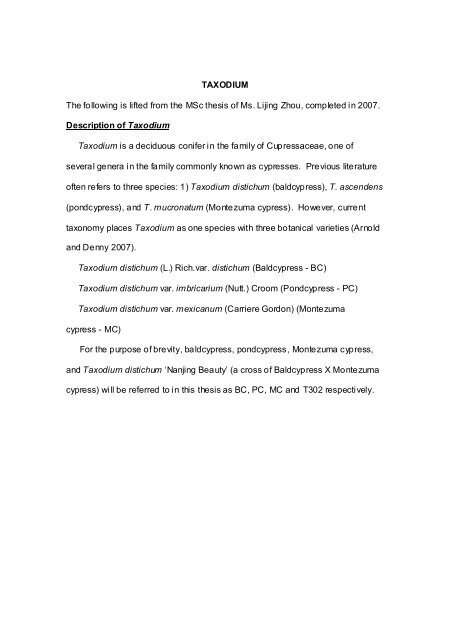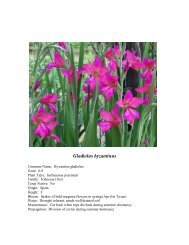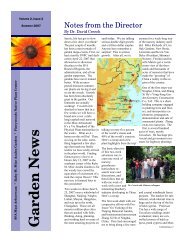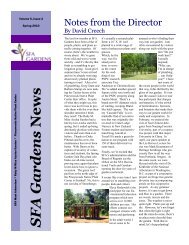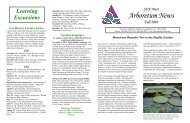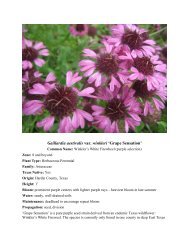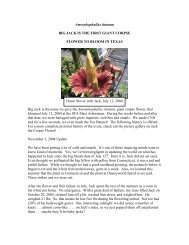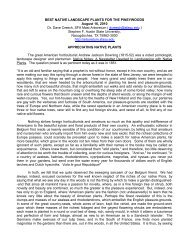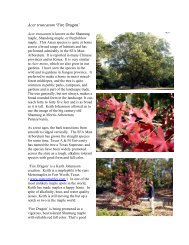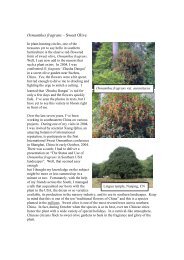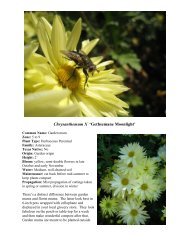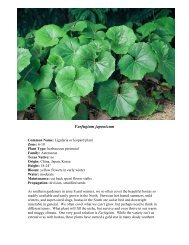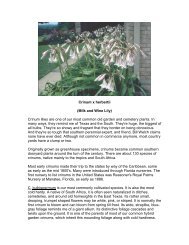TAXODIUM The following is lifted from the MSc ... - SFA Gardens
TAXODIUM The following is lifted from the MSc ... - SFA Gardens
TAXODIUM The following is lifted from the MSc ... - SFA Gardens
You also want an ePaper? Increase the reach of your titles
YUMPU automatically turns print PDFs into web optimized ePapers that Google loves.
<strong>TAXODIUM</strong><br />
<strong>The</strong> <strong>following</strong> <strong>is</strong> <strong>lifted</strong> <strong>from</strong> <strong>the</strong> <strong>MSc</strong> <strong>the</strong>s<strong>is</strong> of Ms. Lijing Zhou, completed in 2007.<br />
Description of Taxodium<br />
Taxodium <strong>is</strong> a deciduous conifer in <strong>the</strong> family of Cupressaceae, one of<br />
several genera in <strong>the</strong> family commonly known as cypresses. Previous literature<br />
often refers to three species: 1) Taxodium d<strong>is</strong>tichum (baldcypress), T. ascendens<br />
(pondcypress), and T. mucronatum (Montezuma cypress). However, current<br />
taxonomy places Taxodium as one species with three botanical varieties (Arnold<br />
and Denny 2007).<br />
Taxodium d<strong>is</strong>tichum (L.) Rich.var. d<strong>is</strong>tichum (Baldcypress - BC)<br />
Taxodium d<strong>is</strong>tichum var. imbricarium (Nutt.) Croom (Pondcypress - PC)<br />
Taxodium d<strong>is</strong>tichum var. mexicanum (Carriere Gordon) (Montezuma<br />
cypress - MC)<br />
For <strong>the</strong> purpose of brevity, baldcypress, pondcypress, Montezuma cypress,<br />
and Taxodium d<strong>is</strong>tichum ‘Nanjing Beauty’ (a cross of Baldcypress X Montezuma<br />
cypress) will be referred to in th<strong>is</strong> <strong>the</strong>s<strong>is</strong> as BC, PC, MC and T302 respectively.
Figure 1. Ranges of Taxodium botanical varieties in <strong>the</strong> USA and Mexico.<br />
Baldcypress<br />
落羽杉<br />
Pondcypress<br />
池杉<br />
Montezuma cypress<br />
墨西哥落羽杉<br />
While BC and PC ranges certainly overlap in many areas across <strong>the</strong> south, <strong>the</strong><br />
nature of overlap of BC and MC ranges <strong>is</strong> less well defined (Figure 1).
Baldcypress (BC) - BC <strong>is</strong> native to<br />
much of <strong>the</strong> sou<strong>the</strong>astern United<br />
States, <strong>from</strong> Delaware to Texas and<br />
inland up <strong>the</strong> M<strong>is</strong>s<strong>is</strong>sippi River to<br />
sou<strong>the</strong>rn Indiana (Figure 1). It occurs<br />
mainly along rivers with silt-rich flood<br />
deposits. BC <strong>is</strong> a durable, long-lived<br />
deciduous conifer particularly well-<br />
adapted to wetland habitats (Cox and<br />
Leslie 1988). <strong>The</strong> tree <strong>is</strong> pollution-<br />
tolerant and excels in compacted, low-<br />
oxygen or swampy conditions. It stands strong in <strong>the</strong> face of hurricanes, <strong>is</strong><br />
amazingly long lived (1000+ years) and, with time, can become quite large. <strong>The</strong><br />
national chamption tree, <strong>The</strong> Senator, <strong>is</strong> located in Longwood, Florida and <strong>is</strong><br />
estimated to be 3500 years old. It was once 165 1 tall but a 1925 hurricane<br />
reduced it to 118’. BC <strong>is</strong> easy to grow <strong>from</strong> seed and <strong>is</strong> relatively free of pests<br />
and d<strong>is</strong>eases. <strong>The</strong> prevalence of knees (pneumatophores) <strong>is</strong> considered a<br />
negative in most landscaping circles as <strong>the</strong>y interfere with routine maintenance<br />
programs.<br />
<strong>The</strong> Senator, Longwood, Florida<br />
While superior clones have been available for years, <strong>the</strong>y have rarely<br />
captured a large portion of <strong>the</strong> baldcypress market. Most plants sold by<br />
nurseries are seedlings and <strong>the</strong>re <strong>is</strong> considerable diversity in form, shape, and<br />
salt and alkalinity tolerance. Propagation by cuttings can be successful with
vigorous shoots as <strong>the</strong> cutting source, particularly if <strong>the</strong> clone <strong>is</strong> young.<br />
According to Larry Hatch’s extensive l<strong>is</strong>t (http://www.raretrees.org/taxodium.html)<br />
<strong>the</strong>re are over 45 cultivars of Taxodium including clones that are pendulous,<br />
contorted, dwarf, salt tolerant, of good form, superior foliage color, etc. Many are<br />
not readily available or are lost to <strong>the</strong> garden world. As might be expected by its<br />
wide range, BC has <strong>the</strong> most varieties, some easier to find than o<strong>the</strong>rs. <strong>The</strong> <strong>SFA</strong><br />
Mast Arboretum, Nacogdoches, Texas, USA has a long h<strong>is</strong>tory of collecting and<br />
planting a wide range of cultivars and genotypes (Appendix A). In addition, <strong>the</strong><br />
<strong>SFA</strong> Mast Arboretum includes seedling trees representing a wide range of<br />
provenances <strong>from</strong> across <strong>the</strong> sou<strong>the</strong>rn USA.<br />
Central and West Texas Baldcypress - BC in <strong>the</strong> western regions of its<br />
range <strong>is</strong> more salt and alkalinity tolerant, and <strong>is</strong> less prone to produce knees than<br />
its more eastern types. Eastern genotypes of Taxodium planted in San Antonio,<br />
Texas, USA often turn chlorotic and sometimes fail to survive. Botan<strong>is</strong>ts and<br />
horticultur<strong>is</strong>ts are convinced that Central to West Texas BC are perhaps<br />
commingled with MC and represents transitional genetics.<br />
Pondcypress - PC occurs in <strong>the</strong><br />
sou<strong>the</strong>rn portion of <strong>the</strong> range of BC<br />
and only on <strong>the</strong> sou<strong>the</strong>astern coastal<br />
plain <strong>from</strong> North Carolina into<br />
Lou<strong>is</strong>iana, and to our observation,<br />
perhaps into sou<strong>the</strong>ast Texas<br />
(Shangrila Botanical Gardern, Orange,<br />
Shangrila Botanical <strong>Gardens</strong>, Orange, TX
Texas). It occurs in still blackwater rivers, ponds, bayous and swamps, usually<br />
without silt-rich flood deposits. PC <strong>is</strong> relatively easy to d<strong>is</strong>tingu<strong>is</strong>h via <strong>the</strong> nature<br />
of its fea<strong>the</strong>ry foliage which <strong>is</strong> ascendant, ra<strong>the</strong>r than more splayed and flat as in<br />
BC, but th<strong>is</strong> may not always be cons<strong>is</strong>tent. Hardin (1971) was first to speculate<br />
on <strong>the</strong> nature of intermediates where BC and PC ranges overlap. Landscapers<br />
often use PC as a specimen particularly when mo<strong>is</strong>t soil conditions ex<strong>is</strong>t – and a<br />
smaller stature <strong>is</strong> desired.<br />
Montezuma cypress (MC) - Less well known in sou<strong>the</strong>rn USA landscapes,<br />
MC <strong>is</strong> native to Mexico, <strong>the</strong> tip of South Texas and remnant populations near Las<br />
Cruces, New Mexico (Figure 1). MC differs <strong>from</strong> BC and PC in being<br />
substantially evergreen, produces smaller seed, never produces d<strong>is</strong>tinct knees,<br />
and <strong>is</strong> generally more salt and alkaline tolerant. It <strong>is</strong> less likely to survive<br />
extended periods of flooding. Where adapted, usually in Zones 8 and 9, MC has<br />
a much faster growth rate than BC and PC. MC forces new growth early in <strong>the</strong><br />
spring and continues to grow late into <strong>the</strong> fall. Observations of MC in Zone 8 and<br />
lower suggest that <strong>the</strong>re may be hardiness and winter damage <strong>is</strong>sues,<br />
particularly with trees derived <strong>from</strong> lowland, tropical Mexico genotypes. <strong>The</strong>se<br />
may fail in Zones 7 and lower in <strong>the</strong> U.S. Th<strong>is</strong> may be a seed source<br />
provenance problem and <strong>the</strong>re <strong>is</strong> good reason to believe that MC can be grown<br />
much fur<strong>the</strong>r north if <strong>the</strong> proper genotypes are selected as seed sources. A<br />
genotype <strong>from</strong> near Las Cruces, New Mexico shows great prom<strong>is</strong>e. Th<strong>is</strong> d<strong>is</strong>junct<br />
population <strong>is</strong> reported to have endured - 31.7 o C. MC <strong>is</strong> not usually considered a<br />
superior landscape tree; it often fails to form a strong central leader and can
develop a somewhat wild and<br />
unbalanced form. Landscapers in<br />
Texas and Lou<strong>is</strong>iana often report<br />
that MC “fails to grow old<br />
gracefully”. However, <strong>the</strong>re are<br />
many exceptions to th<strong>is</strong> rule and<br />
MC can be quite balanced and<br />
uniform. MC can become huge,<br />
and live for thousands of years. A<br />
MC near Oaxaca, Mexico, <strong>the</strong><br />
famous 2500 year-old “Arbole de<br />
Tule”, features a trunk over 17 m in<br />
diameter and <strong>is</strong> estimated to be<br />
Oaxaca, Mexico<br />
over 2500 years old. It <strong>is</strong> often referred to as <strong>the</strong> world’s largest tree.<br />
Nurserymen rarely grow MC and <strong>the</strong>re only a few varieties have been<br />
named. Paul Cox of <strong>the</strong> San Antonio Botanical Garden has introduced ‘Sentido’<br />
(Span<strong>is</strong>h for crying), which <strong>is</strong> modestly weeping and a beautiful tree. Cedar<br />
Lodge Nursery in New Zealand has a form <strong>the</strong>y have named ‘McClaren Falls’, a<br />
mounding weeper of unknown proportions at maturity. Unfortunately, five grafted<br />
plants of that variety failed to survive at <strong>SFA</strong> for unknown reasons. At <strong>the</strong> <strong>SFA</strong><br />
Mast Arboretum, <strong>the</strong>re are several MC specimens worth noting. One particular<br />
tree, first planted in 1988, survived <strong>the</strong> December 23, 1989 freeze (-17.8 o C) with<br />
no damage. In <strong>the</strong> <strong>SFA</strong> Mast Arboretum, MC withstood droughts of considerable
magnitude. <strong>The</strong> <strong>SFA</strong> Montezuma cypresses lost <strong>the</strong>ir foliage in summer<br />
droughts several times, but each time <strong>the</strong>y quickly pushed new growth when<br />
rains or irrigation finally arrived. Vigorous trees often keep <strong>the</strong>ir foliage through<br />
most of <strong>the</strong> winter.<br />
Value of Taxodium<br />
Taxodium has numerous attributes that qualify it as a supreme urban<br />
landscape tree and as a species to mediate harsh coastal wetlands and<br />
floodplains of major rivers in <strong>the</strong> South. Riverine swamps of BC cause<br />
floodwaters to spread out, slow down, and infiltrate <strong>the</strong> soil. Thus, <strong>the</strong>se stands<br />
reduce damage <strong>from</strong> floods and act as sediment and pollutant traps. <strong>The</strong> tree<br />
once dominated large areas of <strong>the</strong> sou<strong>the</strong>rn USA and had a fascinating h<strong>is</strong>tory in<br />
early American forestry. <strong>The</strong> species was heavily cut in <strong>the</strong> late 1800s and early<br />
1900s. Only a few patriarchs survived. Even second and third growth cuts have<br />
not prevented <strong>the</strong> species <strong>from</strong> being quite resilient when environmental<br />
conditions fit its preference. <strong>The</strong> wood has long been valued for its res<strong>is</strong>tance to<br />
rot and warp once cured. In addition, cypress bark <strong>is</strong> very popular in landscaping<br />
circles as a long-lived mulch that doesn’t wash away in rains.<br />
Genetic Variation in Taxodium<br />
Genetic variation in Taxodium has received limited attention in <strong>the</strong> USA and<br />
most trees planted in <strong>the</strong> USA are seedlings <strong>from</strong> a wide range of seed sources.<br />
Very little attention has been paid to superior genotypes as a seed source and<br />
horticultural varieties are rarely encountered outside of botanical gardens and<br />
arboreta. While most studies conclude that BC and PC are not d<strong>is</strong>tinctly different
enough to be a separate species, researchers note that <strong>the</strong>re <strong>is</strong> considerable<br />
variation in character<strong>is</strong>tics and <strong>the</strong> genetic foundation for improvement <strong>is</strong> quite<br />
broad (Lickey and Walker 2002). In many landscapes across <strong>the</strong> sou<strong>the</strong>rn USA,<br />
a “line” of uniform bald cypress at planting almost always evolves into varied<br />
forms, growth rates, foliage color, limb structure, etc.<br />
Tsumura et al. (1999) found very little genetic differentiation between BC and<br />
PC, but <strong>the</strong>ir study included only 20 individuals <strong>from</strong> each of six populations of<br />
BC and seven populations of PC in Florida and extreme sou<strong>the</strong>rn Georgia.<br />
Beilman (1947), Flint (1974), McMillan (1974), and Sharma and Madsen (1978)<br />
reported on seed source and provenance variation. Faulkner and Toliver (1983)<br />
found seed source effects for cone size and seed weight, but failed to find<br />
geographic variation for number of insect galls per cone, height, and diameter,<br />
but <strong>the</strong>y concluded that because <strong>the</strong> scope of <strong>the</strong>ir work was ra<strong>the</strong>r limited <strong>the</strong>y<br />
were unable to detect geographic variation. In ano<strong>the</strong>r study, <strong>the</strong> seed<br />
characters and young seedling growth of BC <strong>from</strong> 11 locations in six U.S.A.<br />
states were studied in China and <strong>the</strong> results indicated <strong>the</strong>re were significant<br />
differences among 34 progenies concerning <strong>the</strong> measured variables that<br />
included seed length, 1000-seed weight, seed vigor, <strong>the</strong> length of leaves of 60-<br />
day-old seedlings, height growth of young seedlings, diameter growth, and<br />
biomass of seedlings (Cao F et al. 1995). In ano<strong>the</strong>r study, seed origin of MC<br />
had no effect on cumulative germination percentage for two seed sources <strong>from</strong><br />
New Mexico (St. Hilaire 2001).
All of <strong>the</strong> above-mentioned studies dealt with Taxodium as a forest tree and<br />
not as an ornamental for <strong>the</strong> nursery and landscape industry. Denny et al.<br />
(2006) are currently screening genotypes for salt tolerance and good landscape<br />
form at Texas A and M University (Appendix B). <strong>The</strong>y have reported that <strong>the</strong>re <strong>is</strong><br />
influence of seed source on tolerance to salt, high pH and alkalinity, and Mexico<br />
MC and western BC were generally less adversely affected by higher alkalinity<br />
levels than more eastern populations (Denny et al. 2006). Rockwood in Florida<br />
<strong>is</strong> evaluating Taxodium seed sources and field trials are underway (Rockwood,<br />
personal communication, 2006). Finally, Krauss at <strong>the</strong> Wetlands Research<br />
Center <strong>is</strong> evaluating a wide range of salt-tolerant BC <strong>from</strong> various provenances in<br />
<strong>the</strong> coastal south (Krauss, personal communication, 2006).<br />
Hybrids<br />
Chinese scient<strong>is</strong>ts are convinced that<br />
controlled Taxodium hybridization<br />
prom<strong>is</strong>es to combine <strong>the</strong> best<br />
character<strong>is</strong>tics of superior parents. In<br />
1988, clones T302 (BC X MC), T401 (PC<br />
X MC), and T202 (PC X BC) were<br />
selected in China primarily for growth rate<br />
and tolerance to alkaline and salt-rich<br />
coastal floodplains. All hybrids are<br />
intermediate types as far as<br />
Nanjing Botanical Garden<br />
photosyn<strong>the</strong>tic activities are concerned and <strong>the</strong> genetic influence of <strong>the</strong> male
parent was greater than that of <strong>the</strong> female. <strong>The</strong> height and breadth of <strong>the</strong><br />
hybrids have positive correlation with photosyn<strong>the</strong>tic intensity (Wu S et al. 1990).<br />
<strong>The</strong> mean annual increment and current annual increment curve of volume<br />
indicate that T302 grows well under alkaline soil condition (pH≤8.5), while BC<br />
would be comparatively inhibited (Zhou K et al. 2000). T302 <strong>is</strong> recommended in<br />
China for soils with pH 8.0~8.5 and salt concentrations < 2 ppt (34 moles⋅m -3 ).<br />
T301, T401, and T302 have higher salt tolerance than BC and PC. O<strong>the</strong>r<br />
attributes of T302 included 159% faster growth than BC, good columnar form,<br />
and longer foliage retention in fall and early winter, and no knees (Chen Y et al.<br />
1987).<br />
In one Chinese study, growth rate (height and root diameter), and biomass<br />
above-ground as well as twig structure of <strong>the</strong> first backcrossed generations of<br />
(BCF1) Taxodium ‘Zhongshansha 302’ X MC were monitored during <strong>the</strong> first<br />
three years after planting. <strong>The</strong> results indicated that “<strong>the</strong> average growths of<br />
height and biomass above ground of BCF1102, BCF1118, BCF161 and BCF1149<br />
were significantly higher than <strong>the</strong> mo<strong>the</strong>r plant T302. Experiments in saline-alkali<br />
soil (pH 8.5) indicated that <strong>the</strong> growth rates of BCF1102, BCF1118 and BCF1149<br />
were superior to T302 except <strong>the</strong> growth of BCF161 was slightly less. <strong>The</strong><br />
relationships between twig structure and tree height were concluded by path<br />
analys<strong>is</strong>, it indicated that twig number was a determinative factor to <strong>the</strong> growth of<br />
height” (Yin Y et al. 2003). Yin X et al. (2002) analyzed <strong>the</strong> <strong>is</strong>ohyets of peroxides<br />
(POD) and super oxide d<strong>is</strong>putes (SOD) in leaves of MC, T302 and four strains of<br />
of <strong>the</strong>ir hybrids. <strong>The</strong> result indicated that “SOD expressed only in May and POD
<strong>is</strong>ohyets had a certain difference among of six samples in May and July, but<br />
notable differences ex<strong>is</strong>ted in September and POD <strong>is</strong>ohyets were a suitable<br />
enzyme system to d<strong>is</strong>tingu<strong>is</strong>h <strong>the</strong> various hybrids.”<br />
Li H (2006) completed a genetic analys<strong>is</strong> of 18 Taxodium genotypes and<br />
found considerable diversity using RAPD (Random Amplified Polymorphic DNA).<br />
According to <strong>the</strong> cluster analys<strong>is</strong>, <strong>the</strong> results indicated that “<strong>the</strong> genetic<br />
relationship between Taxodium d<strong>is</strong>tichum Rich. and T.ascendens Brongn. <strong>is</strong><br />
nearer; <strong>the</strong> genetic relationship of first crossed generation (F1) Taxodium<br />
‘zhongshansha 302’ [Taxodium d<strong>is</strong>tichum (Linn.) Rich. X T. mucronatum Tenore]<br />
<strong>is</strong> closer to <strong>the</strong> female parent Taxodium d<strong>is</strong>tichum (Linn.) Rich.. When <strong>the</strong><br />
threshold <strong>is</strong> 5.0, <strong>the</strong> first backcrossed generations (BCF1) belong to 3 groups:<br />
BCF1149 <strong>is</strong> <strong>the</strong> first group; BCF1102 <strong>is</strong> <strong>the</strong> second group; BCF1 1, 27,118,140,<br />
86,136 formed <strong>the</strong> third group, <strong>the</strong><br />
clustering results were in cons<strong>is</strong>tence<br />
with that of <strong>the</strong> analys<strong>is</strong> of morphology.<br />
BCF1149 might be used as <strong>the</strong> type of<br />
fast-growing ornamental forest.<br />
BCF1118 and BCF1102 might be used as<br />
<strong>the</strong> type of fast-growing timber forest”.<br />
T302 has been in <strong>the</strong> USA since<br />
January 2002 and <strong>is</strong> currently under<br />
evaluation in over 30 locations in<br />
T302 near Suzhou China<br />
sou<strong>the</strong>rn USA. <strong>The</strong> clone was named ‘Nanjing Beauty’ in 2004 as a cooperative
introduction of <strong>the</strong> <strong>SFA</strong> Mast Arboretum and Nanjing Botanical Garden. In March<br />
2005, <strong>the</strong> <strong>SFA</strong> Mast Arboretum received two new clones <strong>from</strong> Professor Yin<br />
Yunlong’s program at <strong>the</strong> Nanjing Botanical Garden; T140 and T27 are<br />
considered more evergreen than T302 and both demonstrate strong salt<br />
tolerance. <strong>The</strong> clones were selected <strong>from</strong> a field population of T302 X MC – with<br />
strong MC character<strong>is</strong>tics and improvements in growth rate, salt tolerance, form<br />
and vigor. T140 grows faster than T27, which produces a wider profile. Nanjing<br />
scient<strong>is</strong>ts believe <strong>the</strong>y have selected ano<strong>the</strong>r clone, T1, that may be superior to<br />
both T140 and T27, but more genotype X environment studies are needed. <strong>The</strong><br />
foundation of <strong>the</strong> most recent selections comes originally <strong>from</strong> crosses made by<br />
Professor Chen and Liu in 1992 at <strong>the</strong> Nanjing Botanical Garden. Pollen <strong>from</strong><br />
MC was applied to a female T302 and fifteen selections were made in 1995. <strong>The</strong><br />
main character<strong>is</strong>tics for selection were 1) fast growth rate, 2) dark green color<br />
during <strong>the</strong> growing season and a red-orange leaf color in <strong>the</strong> autumn, and 3)<br />
evergreen leaves. In 2006 or 2007, <strong>the</strong> results <strong>from</strong> T140 and T27 will be<br />
reported and reg<strong>is</strong>tered with <strong>the</strong> Chinese Forestry Department. It will be at least<br />
five years before T140 and T27 enter commerce. In June, 2005 <strong>the</strong>re were less<br />
than 100 each of <strong>the</strong>se two clones. T118, T120 and T149 have already been<br />
reg<strong>is</strong>tered with <strong>the</strong> Chinese Forestry Department at <strong>the</strong> provincial level, while<br />
T302 has been reg<strong>is</strong>tered at <strong>the</strong> national level.<br />
An interesting intergeneric hybrid X Taxodiomeria peizhongii Z.J.Ye,<br />
J.J.Zhang et S.H. Pan (a cross between MC and Cryptomeria fortunei Hooibrenk<br />
ex Otto et Dietr.) was reported to have been created in Nanjing, China in 1963.
<strong>The</strong> hybrids are semi-evergreen, grow fast, hold up to strong winds, have no<br />
butswells and buttresses. <strong>The</strong> trunk <strong>is</strong> usually divided at a height of 5-8 m into<br />
two or more primary branches. <strong>The</strong>y thrive in wetlands and saline sea-shores<br />
with a soil pH ranging <strong>from</strong> 6.5 to 8.6. <strong>The</strong> trees can grow in saline soil with 4 ppt<br />
(68 moles⋅m -3 ) salt. <strong>The</strong>y are useful for landscape planting as well as for large-<br />
scale windbreaks in reverie and coastal regions (Zhang J et al. 2003).<br />
Chen Y et al. (2002) conducted RAPD analyses on genetic polymorph<strong>is</strong>ms of<br />
twelve fir genotypes to identify <strong>the</strong>ir relationships. <strong>The</strong>se genotypes included<br />
eight suspected hybrid MC forest samples, <strong>the</strong> hybrid female parent—MC, and<br />
<strong>the</strong> same class of hybrid male parent—Cryptomeria fortunei Hooibrenk and sugi<br />
C. Japonica (L.f.) D.Don. <strong>The</strong> results revealed that “<strong>the</strong> genetic relationship of<br />
sample No.11 in three Cryptomeria genotypes <strong>is</strong> <strong>the</strong> closest to <strong>the</strong> original male-<br />
parent; samples No.1, 4 and 9 are most possibly <strong>the</strong> true hybrid MC populations;<br />
sample No.5 may be <strong>the</strong> false hybrid.”<br />
Recently, <strong>the</strong> au<strong>the</strong>nticity of <strong>the</strong> new intergeneric hybrid (X Taxodiomeria<br />
peizhongii Z. J. Ye, J. J. Zhang et S. H. Pan) has been questioned by Chinese<br />
scient<strong>is</strong>ts at <strong>the</strong> Shanghai Botanical Garden. To confirm <strong>the</strong> au<strong>the</strong>nticity of <strong>the</strong><br />
intergeneric hybrid, scient<strong>is</strong>ts analyzed <strong>the</strong> rbcL gene and <strong>the</strong> internal transcribed spacer (ITS )<br />
of 26S–18S ribosomal RNA gene of <strong>the</strong> three species using polymerase chain reaction-restriction<br />
fragment length polymorph<strong>is</strong>m (PCR-RFLP) and arbitrarily primed PCR (AP-P CR), and obtained<br />
<strong>the</strong> <strong>following</strong> results: “(1) Taxodiomeria peizhongii had <strong>the</strong> same RFLP maps of <strong>the</strong> rbcL gene<br />
and <strong>the</strong> ITS as MC, but was different <strong>from</strong> C. fortunei; (2) a 311-bp PCR amplification product<br />
was obtained in C. fortunei by AP-PCR of ITS, but was not found in Taxodiomeria peizhongii.<br />
<strong>The</strong>ir results have demonstrated that C. fortunei did not provide any genome for Taxodiomeria
peizhongii, implying that T. peizhongii <strong>is</strong> not an intergeneric hybrid between <strong>the</strong> two species”<br />
(Ling Y et al. 2006).<br />
Salt Tolerance<br />
Many coastal wetlands of <strong>the</strong> sou<strong>the</strong>astern United States are threatened by<br />
increases in flooding and salinity as a result of both natural processes and man-<br />
induced hydrologic alterations (Allen 1992; Conner and Toliver 1990; Craig et<br />
al.1979; Templet and Meyer-Arendt 1988; Wicker et al. 1981). If predicted<br />
climate changes occur, <strong>the</strong> consequent r<strong>is</strong>e in sea level will cause flooding and<br />
salt water intrusion in many coastal areas (Daniels 1992; Kerr 1991; Smith and<br />
Tirpak 1989; Titus 1988; Wigley and Raper 1993). Salt-tolerant trees can<br />
withstand concentrations up to 40,000 parts per million (ppm) of salt water.<br />
Wahome et al. (2001) define salt tolerance as “<strong>the</strong> ability of a plant to maintain<br />
growth and metabol<strong>is</strong>m under saline conditions”.<br />
Salt can damage trees in two ways. Salt in <strong>the</strong> soil can adversely affect soil<br />
structure and damage a tree’s roots, causing <strong>the</strong> crown to thin; however, aerial<br />
deposition of salt on <strong>the</strong> above-ground parts of a plant causes <strong>the</strong> most damage<br />
and ocean spray <strong>is</strong> <strong>the</strong> primary culprit. <strong>The</strong> average concentration of <strong>the</strong> ocean<br />
water <strong>is</strong> as high as 34.9 parts per thousand (ppt). During extreme conditions,<br />
such as hurricanes, salt spray can affect plants as far as 50 miles inland,<br />
although most damage occurs within 1,000 feet of <strong>the</strong> shore. Salt damage may<br />
take various forms: delayed bud break, reduced leaf size, desiccated leaf<br />
margins and tips, premature fall coloration and leaf fall, bud and stem dieback,<br />
and reduced shoot growth. Salt produces <strong>the</strong>se symptoms by altering osmotic<br />
pressure and, where soil <strong>is</strong> salty, upsetting <strong>the</strong> mineral nutritional balance.
Damage to trees can be minimized by avoiding <strong>the</strong> use of salt around landscape<br />
plants, but, obviously, <strong>the</strong> salt content of ocean spray or storm-caused<br />
inundations can not be changed. It <strong>is</strong> <strong>the</strong>refore essential that species selected<br />
for landscape planting in areas exposed to ocean spray be able to survive and<br />
remain attractive in such environments.<br />
Pezeshki et al. (1995) found salt tolerance differences among populations of<br />
BC. In that study, populations <strong>from</strong> freshwater provenances had greater height<br />
growth, net shoot biomass, and net root biomass, when compared to brack<strong>is</strong>h<br />
populations. <strong>The</strong>y identified a need for fur<strong>the</strong>r investigation to explore population<br />
variations in performance to identify plants tolerant of environmental stresses. In<br />
ano<strong>the</strong>r study, <strong>the</strong> salt tolerance of BC <strong>from</strong> different provenances was varied<br />
and individuals exhibited good pollution tolerance (Wang G and Cao F 2002). In<br />
ano<strong>the</strong>r study, compared to Nyssa aquatica, BC seedlings were able to grow<br />
unaffected by fly ash concentrations up to 10% in sand, concluding that BC was<br />
highly recommended for wetlands containing fly ash (McLeod et al. 1997). In<br />
Lou<strong>is</strong>iana, Krauss et al. (1996, 1998, and 1999) studied intraspecific variation of<br />
salinity tolerance in BC and found genotypes with significantly improved<br />
tolerances.<br />
Wang G and Cao F reported <strong>the</strong> effects of salt stress on growth and uptake<br />
of nutrients of BC under varying soil water content. <strong>The</strong> results indicated that<br />
“<strong>the</strong>re were significant effects of soil water contents (W1, flooding; W2, 75% of<br />
field water capacity; W3, 25% of field water capacity) and soil salt (NaCl)<br />
contents (0, 0.15%, 0.3% and 0.45% of dry weight of soil) on growth and uptake
of nutrients of BC. <strong>The</strong> relative height growth, relative ground diameter growth,<br />
and biomass increment decreased with increase of soil salt content and<br />
decrease of soil water content. <strong>The</strong> total N, P and Na content in root, stem and<br />
leaf and <strong>the</strong> total Ca and Fe content in leaf increased with increase of soil salt<br />
content under <strong>the</strong> soil condition of flooding, while <strong>the</strong> total Fe, Ca and Mg content<br />
in stem and root had little significant difference. <strong>The</strong> total N, Na, Ca and Fe<br />
content in root, stem and leaf and <strong>the</strong> total P, K and Mg content in stem and leaf<br />
increased differently with increase of soil salt content under <strong>the</strong> soil condition of<br />
W2 (75% of field water capacity), while <strong>the</strong> total P, K and Mg content in stem<br />
decreased under higher soil salt content. <strong>The</strong> total N, P and K content in leaf,<br />
<strong>the</strong> total Ca and Mg content in stem and leaf and <strong>the</strong> total Na content in root,<br />
stem and leaf increased differently with increase of soil salt content under <strong>the</strong> soil<br />
condition of W3 (25% of field water capacity), while <strong>the</strong> total N, P and K content<br />
in stem and root and <strong>the</strong> total Fe content in root, stem and leaf decreased with<br />
increase of soil salt content” (Wang G and Cao F 2004 a and b).<br />
Wang G and Cao F reported <strong>the</strong> effects of soil water and salt content on<br />
photosyn<strong>the</strong>tic character<strong>is</strong>tics. <strong>The</strong> results indicated that “<strong>the</strong> net photosyn<strong>the</strong>tic<br />
rate, stomatal conductance, chlorophyll a concentration, chlorophyll b<br />
concentration, and chlorophyll content decreased with increasing of soil salt<br />
(NaCl) contents (0, 0.15%, 0.3% and 0.45% of dry weight of soil) at varying soil<br />
water contents (W1: flooding; W2: water logging; W3: 75% of field water<br />
capacity; W4: 50% of field water capacity; W5: 25% of field water capacity), but<br />
transpiration rate and respiration rate had different changing tendency; <strong>The</strong> net
photosyn<strong>the</strong>tic rate decreased with decreasing of soil water content at varying<br />
soil salt contents, and <strong>the</strong> water treatment of W3 among five soil water levels had<br />
a highest intercellular CO2 concentration, chlorophyll a concentration and<br />
chlorophyll content, but stomatal conductance, transpiration rate, respiration rate,<br />
chlorophyll b concentration and chlorophyll a/b had different changing tendency”<br />
(Wang G and Cao F 2004 c).<br />
While not directly a salt-tolerance study, Wang G and Cao F reported <strong>the</strong><br />
effects of soil water contents on nutrient uptake, including Na, and allocation<br />
nutrients in <strong>the</strong> leaves, stems, and roots of BC. <strong>The</strong> results are as follows:<br />
“(1)<strong>The</strong> total N concentration of root, stem and leaf of BC increased with<br />
increasing of soil water contents, and <strong>the</strong> total P concentration of root, stem and<br />
leaf of W3 among five water treatments (W1, flooding; W2, water logging; W3,<br />
75% of field water capacity; W4, 50% of field water capacity; W5, 25% of field<br />
water capacity) was <strong>the</strong> lowest, flooding or drought stress increased <strong>the</strong> total P<br />
concentration, and <strong>the</strong> total Ca, K, Na, Mg, and Fe concentration in root, stem<br />
and leaf had different changing tendency; (2) <strong>The</strong> order of total N, P, Ca, K, Na,<br />
Mg, and Fe concentration in root, stem and leaf was in <strong>the</strong> order of<br />
leaf>root>stem; (3) <strong>The</strong> total accumulation of nutrients in BC decreased with<br />
decreasing of soil water contents, and <strong>the</strong> allocation ratio of root and stem<br />
increased with decreasing of soil water contents, while <strong>the</strong> allocation ratio of leaf<br />
decreased significantly with decreasing of soil water contents” (Wang G and Cao<br />
F. 2004 d).
Wang G, Cao F and Wang Q reported <strong>the</strong> effects of soil salt contents on<br />
uptake of nutrients of BC. <strong>The</strong> results are as follows: “(1) <strong>The</strong> total N, Ca, Na,<br />
and Fe concentration of root, stem and leaf increased with increasing of soil salt<br />
content (0, 0.15%, 0.3% and 0.45% of dry weight of soil), and total P, K, and Mg<br />
concentration of root decreased with increasing of soil salt content, and total P,<br />
K, and Mg concentration of stem and leaf increased with increasing soil salt<br />
content; (2) Ca/Na of root increased with increasing soil salt content, and Ca/Na<br />
of stem and leaf, K/Na, Mg/Na and Fe/Na of root, stem, and leaf decreased with<br />
increasing of soil salt content; (3) <strong>The</strong> order of total N and P concentration of<br />
root, stem, and leaf was leaf>root>stem, and total Ca concentration was<br />
leaf>stem>root, and total Fe concentration was root>leaf>stem, and <strong>the</strong> order of<br />
total K, Na, and Mg concentration of root, stem and leaf was different with<br />
varying soil salt contents” (Wang G, Cao F and Wang Q. 2004).<br />
Krauss et al. (2000) reported <strong>the</strong> effect of salinity treatment on growth and<br />
nutrition of BC. <strong>The</strong> results indicated that <strong>the</strong> survival, height, diameter, and leaf<br />
biomass differed significantly among salinity treatments in <strong>the</strong> field sites. Leaf<br />
Na, and Cl increased with <strong>the</strong> increase of site salinity; <strong>the</strong> mean K/Na ratios<br />
decreased as <strong>the</strong> salinity levels increased. In ano<strong>the</strong>r study, BC seedlings were<br />
subjected to flooding with salinity levels ranging <strong>from</strong> 0 - 8.3 ppt (0-140 moles ⋅<br />
m -3 ) NaCl. <strong>The</strong> effect of salt water on leaf t<strong>is</strong>sue ion concentrations and<br />
subsequent changes in net photosyn<strong>the</strong>s<strong>is</strong> were measured. <strong>The</strong> result indicated<br />
leaf concentrations of Na, K, Ca, and Mg increased as salinity of floodwater
increased. <strong>The</strong> net photosyn<strong>the</strong>s<strong>is</strong> decreased as <strong>the</strong> salinity increased<br />
(Pezeshki et al. 1988).<br />
Propagation<br />
It <strong>is</strong> a common propagation experience that mature BC seeds freshly<br />
harvested <strong>from</strong> dried cones in <strong>the</strong> late fall or early winter will germinate at high<br />
percentages, with most seeds emerging in 21 – 28 days depending on<br />
temperature. Some propagators recommend a brief soak in rubbing alcohol<br />
followed by a water rinse which removes <strong>the</strong> oily resin on <strong>the</strong> surface of <strong>the</strong> seed,<br />
and th<strong>is</strong> can improve germination.<br />
In <strong>the</strong> USA, <strong>the</strong> vast majority of BC trees used in <strong>the</strong> landscape trade are <strong>from</strong><br />
seed and <strong>the</strong> variation <strong>is</strong> often quite d<strong>is</strong>tinct when <strong>the</strong> tree reaches five to ten<br />
years of age. Variation includes tree size, tree form, foliage color, branching,<br />
density of branching, and o<strong>the</strong>r v<strong>is</strong>ual character<strong>is</strong>tics. Superior varieties are<br />
generally grafted and thus more costly to produce. Cutting propagation offers a<br />
robust method to quickly multiply a<br />
clone to significant nursery numbers<br />
but rooting percentages are often low<br />
and <strong>the</strong> species <strong>is</strong> considered “difficult<br />
to root”.
Yunlong reports that T302, selected in 1988, <strong>is</strong> no longer easy to root, a<br />
condition attributed to chronological and physiological age factors. To counter<br />
lower rooting percentages, a strict protocol for achieving success has been<br />
developed. Chinese nurserymen encourage one year old clones to produce<br />
vigorous cutting wood in <strong>the</strong> second year. T302 plants are field planted at close<br />
spacing. <strong>The</strong> plants are grown one year and <strong>the</strong>n cut back in <strong>the</strong> winter to 1’ – 3’<br />
(0.31 – 0.91 m) tall. Th<strong>is</strong> severe pruning results in vigorous upright shoots that<br />
provide cuttings that root in good percentages, and produce upright growing<br />
plants of better form than trees produced <strong>from</strong> side branches (plagiotropic<br />
growth). Cuttings are rooted under part shade using intermittent m<strong>is</strong>t and a well<br />
drained mix in rooting beds. While rooting hormones are utilized, cutting wood<br />
quality and maintaining good turgor are recognized as critical for high rooting<br />
percentages. One upright shoot <strong>is</strong> left on <strong>the</strong> stock tree to grow for <strong>the</strong> rest of <strong>the</strong><br />
season which produces a tree that can <strong>the</strong>n be dug for sale as a straight 6 – 8’<br />
(1.86 - 2.48 m) tree at <strong>the</strong> end of <strong>the</strong> second year.<br />
In a Chinese article, <strong>the</strong> selection of Taxodium ‘zhongshansha’ cutting<br />
substrate, cutting of wood and maintenance of three main ecological factors<br />
(temperature, mo<strong>is</strong>ture and illumination after cutting cultivation), and <strong>the</strong>ir effects<br />
on taking root were provided. <strong>The</strong> result indicated that T302 had higher rooting<br />
percentage (52.4%) using sandy loam as <strong>the</strong> cutting medium in a plastic shed<br />
than using sandy alkaline soil (pH 8) as cutting medium or using a 75% yellow<br />
soil / 25% sand substrate (Lu X et al. 2004). In ano<strong>the</strong>r Chinese study, <strong>the</strong> 1-2 –<br />
year – old branches of T302 with higher res<strong>is</strong>tance and superior characters were
used as experimental materials, plant ash + soil as cutting medium, and 1.5 mg/L<br />
NAA X IAA as <strong>the</strong> rhizogenic accelerant, <strong>the</strong> rooting percentage was about<br />
eighty-seven percent (Dong B 2005). Huang L et al.(2000) found that significant<br />
variation ex<strong>is</strong>ted among <strong>the</strong> provenances and families in Genus Taxodium in six<br />
rooting character<strong>is</strong>tics (survival rate, rooting rate, sum of adventitious roots, total<br />
length of adventitious roots, rooting perform indexes, and length of terminal<br />
shoots).<br />
LITERATURE CITED<br />
Allen, J.A. 1992. Cypress-tupelo swamp restoration in sou<strong>the</strong>rn Lou<strong>is</strong>iana.<br />
Restor. Manage. Notes 10:188-189.<br />
Arnold, M.A. 2002. Landscape Plants for Texas and Environs, Sec. Ed. p. 1088.<br />
Stipes Publ. L.L.C., Champaign, Ill.<br />
Arnold, M.A., and G.C. Denny. 2007. Taxonomy and nomenclature of<br />
Baldcypress, Pondcypress, and Montezuma Cypress: One, two, or three<br />
species? HortTechnology 17(1): 125-127<br />
Beilman, A.P. 1947. What happens when all kinds of sou<strong>the</strong>rn cypress are<br />
grown in <strong>the</strong> north? Sou<strong>the</strong>rn Lumberman 174 (2179):48.<br />
Cao F, Fang S, Tang L, Xu L, Liu C, Huang J and Suan Y. 1995. A study on<br />
provenance tests of Taxodium D<strong>is</strong>tichum seeds. Journal of Nanjing Forestry<br />
University (Natural Science Edition) 19(1):66-70<br />
Chen Y, Wang M, Wu S, Liu L, and He S. 1987. Interspecific Hybridization and<br />
Breeding of Genus Taxodium for Fast-Growing and Alkaline Tolerance.<br />
Nanjing Zhongshan Botanical Garden Research Papers.1987, 92-98.<br />
Chen Y, Pan S, Zhang J, Zhu W, Niu H, Qu Z, Wang J, Shen D and Ye Z. 2002.<br />
RAPD Analys<strong>is</strong> of Genetic Relationships among Natural Populations of<br />
Hybrid Taxodium mucronatum Tenore. Journal of Fudan University (Natural<br />
Science). 41(6):641-645.
Clough, B.F. 1984. Growth and salt balance of <strong>the</strong> mangroves, Avicennia<br />
marina and Rhizophora stylosa in relation to salinity. Aust. J. Plant Physiol.,<br />
11:419-430.<br />
Conner, W.H and J.R. Toliver. 1990. Long-term trends in <strong>the</strong> baldcypress<br />
(Taxodium d<strong>is</strong>tichum) resource in Lou<strong>is</strong>iana (USA). For. Ecol. Manage.<br />
33/34:543-557.<br />
Cox, P.W. and P. Leslie. 1988. Texas Trees: A Friendly Guide. Corona Publ.<br />
Co., SanAntonio, Texas.<br />
Craig, N.J., R.E. Turner and J.W. Day, Jr. 1979. Land loss in coastal Lou<strong>is</strong>iana<br />
(USA). Environ. Manage. 3:133-144.<br />
Daniels, R.C. 1992. Sea-level r<strong>is</strong>e on <strong>the</strong> South Carolina coast: two case<br />
studies for 2100. J. Coastal Res. 8:56-70.<br />
Denny, G., M.A. Arnold, and D. Bryan. 2006. Effect of provenance on alkalinity<br />
tolerance of Baldcypress. HortSci. 41(4):1004 (abstract).<br />
Dickson, R.E., J.F. Honser, and N.W. Hosley. 1965. <strong>The</strong> effects of four water<br />
regimes upon <strong>the</strong> growth of four bottomland tree species. For. Sci. 11:299-<br />
305<br />
Dong B. 2005. Breeding Experiment and Research of “Three Layers of Keeping<br />
Warm” of Taxodium ‘Zhongshansa’. Forestry Science &Technology. 30(3):7-<br />
9.<br />
Earles, J.M. 1975. Forest stat<strong>is</strong>tics for Lou<strong>is</strong>iana Par<strong>is</strong>hes U.S. For. Serv. South.<br />
For. Exp. Stn. Res. Bull. SO-52.<br />
Faulkner, S. and Toliver, J. 1983. Genetic variation of cones, seeds, and<br />
nursery-grown seedlings of baldcypress (Taxodium d<strong>is</strong>tichum (L.) Rich.)<br />
provenances. p. 281-288. In: Sou<strong>the</strong>rn Forest Tree Improvement Committee<br />
(Eds.), Proceedings of <strong>the</strong> 17 th Sou<strong>the</strong>rn Forest Tree Improvement<br />
Conference, June 6-9, University of Georgia, Ga.<br />
Flint, H.L. 1974. Geographically based physiological variation in Taxodium<br />
d<strong>is</strong>tichum (L.) Rich. HortScience 9:301 (abstract).<br />
Hardin, J.W. 1971. Studies of <strong>the</strong> Sou<strong>the</strong>astern United States Flora. II. <strong>The</strong><br />
Gymnosperms. Journal of <strong>the</strong> El<strong>is</strong>a Mitchell Scientific Society 87:43-50.<br />
Hartmann H.T., D.E. Kester and F.T. Davies. 1990. Plant Propagation:<br />
Principles and Practices. 5 th ed. p. 647. Prentice-Hall publ<strong>is</strong>hers, Englewood<br />
Cliff, New Jersey, USA.
Huang L, Wang Q ,Li X, Wang W, Chen Z and Jiang Z. 2000. Studies on <strong>the</strong><br />
variation of provenances and families in Genus Taxodium: variation on shoot<br />
cutting rooting ability. Journal of Jiangsu Forestry Science & Technology.<br />
27(1):1-6<br />
Kerr, R.A. 1991. Cooling <strong>the</strong> greenhouse cheaply. Science 251:621.<br />
Krauss, K.W., J.L. Chambers, and J.A. Allen. 1996. Intraspecific variation in<br />
physiological response of baldcypress (Taxodium d<strong>is</strong>tichum (L.) Rich.) to a<br />
rapid influx of saltwater. p. 183-189. In: Flynn, K.M. (Ed.), Proc. of <strong>the</strong><br />
Sou<strong>the</strong>rn Forested Wetlands Ecol. and Mgmt. Conf., March 25-27. Clemson,<br />
SC.<br />
Krauss, K.W., J.L. Chambers, and J.A. Allen. 1998. Salinity effects and<br />
differential germination of several half-sib families of baldcypress <strong>from</strong><br />
different seed sources. New Forests 15:53-68.<br />
Krauss, K.W., J.L. Chambers, J.A. Allen, B.P. Luse, and A.S. DeBosier. 1999.<br />
Root and shoot responses of Taxodium d<strong>is</strong>tichum seedlings subjected to<br />
saline flooding. Environ. Expt. Bot. 41:15-23.<br />
Krauss, K.W, J.L. Chamber, J.A. Allen, D.M. Soileau, Jr., A.S.,DeBoier. 2000.<br />
Growth and nutrition of baldcypress families planted under varying salinity<br />
regimes in Lou<strong>is</strong>iana, USA. J Coast Res 16:153-163.<br />
Krauss, K.W. 2006. personal communication.<br />
Lickey, E.B., and G.L. Walker. 2002. Population genetic structure of<br />
baldcypress (Taxodium d<strong>is</strong>tichum (L.) Rich. var. d<strong>is</strong>tichum and Pondcypress<br />
(T. d<strong>is</strong>tichum var. imbricarium (nuttall) Croom: Biogeographic and Taxonomic<br />
Implications. Sou<strong>the</strong>astern Natural<strong>is</strong>t 1(2):131-148.<br />
Li H. 2006. Study on genetic analys<strong>is</strong> on Taxodium Rich. using RAPD. MS<br />
<strong>the</strong>s<strong>is</strong>, Nanjing Agriculture University, Nanjing 210095, P.R. China. p. 44.<br />
Ling Y, Lu W, Lu F, Wang Y, Chen J, and Zhang W. 2006. PCR-RFLP and AP-<br />
PCR of rbcL and ITS of rDNA show that ×Taxodiomeria peizhongii (Taxodium<br />
× Cryptomeria) <strong>is</strong> not an intergeneric hybrid. J Integrat Plant Biol 48(4), 468-<br />
472.<br />
Lu X, Mao Z, Chen Y, and Huang L. 2004. Propagation technology of Taxodium<br />
‘zhongshansha’. Journal of Jiangsu Forestry Science & Technology 31(6):38-<br />
42
McLeod, K.W. and T.G. Ciravolo. 1997. Differential sensitivity of Nyssa aquatica<br />
and Taxodium d<strong>is</strong>tichum seedlings grown in fly ash amended sand. Wetlands<br />
17:330-335.<br />
McMillan, C. 1974. Differentiation in habitat response in Taxodium d<strong>is</strong>tichum,<br />
Taxodium mucronatum, Platanus occidental<strong>is</strong>, and Liquidambar styraciflua<br />
<strong>from</strong> <strong>the</strong> United States and Mexico. Vegetatio 29:1-10.<br />
Pezeshki, S.R. 1990. A comparative study of <strong>the</strong> response of Taxodium<br />
d<strong>is</strong>tichum and Nyssa aquatica seedlings to soil anaerobios<strong>is</strong> and salinity.<br />
For. Ecol. Manage. 33/34:531-541.<br />
Pezeshki, S.R., R.D. DeLaune, and H.S. Choi. 1995. Gas exchange and growth<br />
of baldcypress seedlings <strong>from</strong> selected U.S. Gulf Coast populations:<br />
Responses to elevated salinities. Can. J. For. Res. 25:1409-1415.<br />
Pezeshki, S.R., R.D. DeLaune, and W. H. Patrick. 1988. Effect of salinity on<br />
leaf ionic content and photosyn<strong>the</strong>s<strong>is</strong> of Taxodium d<strong>is</strong>tichum L. <strong>The</strong><br />
American Midland Natural<strong>is</strong>t 119(1):185-192.<br />
Rockwood, D. 2006. Personal Communication.<br />
Sharma, G.K. and L. Madsen. 1978. Variation in baldcypress <strong>from</strong> different<br />
habitats. J. Tenn. Acad. Sci. 53:115-116.<br />
Smith, J. B. and D. Tirpak. 1989. <strong>The</strong> potential effects of global climate change<br />
on <strong>the</strong> United States: report to Congress. U.S. Environmental Protection<br />
Agency, Washington, D.C., EPA-230-05-89-050, p. 413.<br />
St. Hillaire, R. 2001. Seed coat treatments influence germination of Taxodium<br />
mucronatum. Desert Plants 17(1):15-18.<br />
Swamy S.L., Puri S. and Kanwar K. 2002. Propagation of Robinia pseudoacacia<br />
Linn. And Grewia optiva Drummond <strong>from</strong> rooted stem cuttings. Agroforestry<br />
Systems 55: 231-237.<br />
Templet, P.H. and K.J. Meyer-Arendt. 1988. Lou<strong>is</strong>iana wetland loss: a regional<br />
water management approach to <strong>the</strong> problem. Environ. Manage. 12:181-192.<br />
Titus, J.G. 1988. Greenhouse effect, sea level r<strong>is</strong>e and coastal wetlands. U.S.<br />
Environmental Protection Agency, Washington, D.C., EPA-230-05-86-013,<br />
p.152.<br />
Tsumara, Y., N. Tomaru, Y. Suyama, and S. Bacchus. 1999. Genetic diversity<br />
and differentiation of Taxodium in <strong>the</strong> south-eastern United States using<br />
cleaved amplified polymorphic sequences. Heredity 83:229-238.
Wahome, P.K., H.H. Jesch, and I. Grittner. 2001. Mechan<strong>is</strong>ms of salt tolerance<br />
in two rose rootstocks: Rosa chinens<strong>is</strong> ‘Major’ and R. rubiginosa. Scientia<br />
Hort. 87:207-216.<br />
Wang G and Cao F. 2002. Review on res<strong>is</strong>tance of baldcypress. Journal of<br />
Nanjing Forestry University (Natural Science Edition) 26(6):78-82.<br />
Wang G and Cao F. 2004 a. Effect of Salt Stress on Growth and Uptake of<br />
Nutrient of Taxodium d<strong>is</strong>tichum under Varying Soil Water Content. SCIENTIA<br />
SILVAE SINICAE. 40(6): 56-59<br />
Wang G and Cao F. 2004 b. Effects of soil salt and water contents on growth<br />
and biomass allocation of Taxodium d<strong>is</strong>tichum. Chinese Journal of Applied<br />
Ecology. 15(12): 2396-2400.<br />
Wang G and Cao F. 2004 c. Effects of Soil Water and Salt Contents on<br />
Photosyn<strong>the</strong>tic Character<strong>is</strong>tics. Journal of Nanjing Forestry University<br />
(Natural Sciences Edition). 28(3):15-18<br />
Wang G and Cao F. 2004 d. Effects of Soil Water Contents on Nutrient Uptake<br />
and Allocation of Baldcypress. Forest Research. 17(2): 213-219.<br />
Wang G, Cao F, and Wang Q. 2004. <strong>The</strong> Effect of Soil Salt Contents on Uptake<br />
of Nutrients of Baldcypress. Journal of Fujian College of Forestry. 24(1): 58-<br />
62.<br />
Wicker, K.M., D. Dav<strong>is</strong>, M. DeRouten and D. Robert. 1981. Assessment of<br />
extent and impact of saltwater intrusion into <strong>the</strong> wetlands of Tangipahoa<br />
Par<strong>is</strong>h, Lou<strong>is</strong>iana. Coastal Environments Inc., Baton Rouge, LA, p. 59.<br />
Wigley, T.M.L. and S.C.B. Raper. 1993. Future changes in global mean<br />
temperature and sea level. In Climate and Sea Level Change: Observations,<br />
Projections, and Implications. p. 111-113. Eds. R.A. Warrick, E.M. Barrow<br />
and T.M.L. Wigley. Cambridge Univ. Press, Cambridge, U.K.<br />
Will<strong>is</strong>ton, H.L., F.W. Shropshine, and W.E. Balmer. 1980. Cypress<br />
management: a forgotten opportunity. USDA For. Serv. Sou<strong>the</strong>ast. Exp.<br />
Stn. For. Rep. SA-FR-8.<br />
Wu S, Chen Y and Wang M. 1990. A preliminary study of photosyn<strong>the</strong>tic<br />
character in Zhongsansa 302. Journal of Jiangsu Forestry Science and<br />
Technology. 17(4):9-12<br />
Yin X, Yin Y and Chen Y. 2002. Isozyme analys<strong>is</strong> of Taxodium ‘Zhongshansha<br />
302’, T.mucronatum Tenore and <strong>the</strong>ir hybrids. Journal of Plant Resources<br />
and Environment. 11(3):59-61.
Yin Y, Yin X, Yu C, Xu J and Chen Y. 2003. Selection on backcrossed F1 of<br />
Taxodium ‘zhongshansha’ X T.mucronatum at early stage. Journal of Plant<br />
Resources and Environment. 12(2): 22-27.<br />
Zhang J, Pan S, Zhu W, Niu H, Ye Z, Zhu J and Hu P. 2003. Taxodiomeria<br />
(Taxodiaceae), an intergeneric hybrid between Taxodium and Cryptomeria<br />
<strong>from</strong> Shanghai, People’s Republic of China. BRIT.ORG/SIDA. 20(3): 999-<br />
1006.<br />
Zhou K, Jia C, Chen Y, Yin Y, Sun Z. 2000. Analys<strong>is</strong> on growth of Taxodium<br />
d<strong>is</strong>tichum and T. ‘zhongshansha’ on <strong>the</strong> alkaline low-and. Journal of Jiangsu<br />
Forestry Science & Technology. 2000, 27(5): 16-18.


